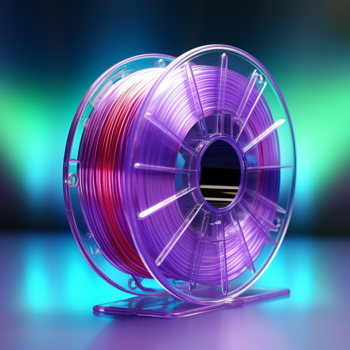3D printing has revolutionized the manufacturing industry, enabling the creation of complex and customized objects with ease. Among the plethora of materials available for 3D printing, PETG stands out due to its unique properties and versatility. In this blog post, we delve into the world of PETG, exploring its origins, characteristics, advantages, and applications in 3D printing.
Origins of PETG: PETG, or Polyethylene Terephthalate Glycol-modified, is a thermoplastic polymer that belongs to the polyester family. It is derived from PET, the same material used to make water bottles, but modified with glycol to enhance its properties for 3D printing applications. The inclusion of glycol prevents the material from crystallizing and becoming brittle, making PETG more durable and easier to use than its unmodified counterpart.
Characteristics of PETG:
- Durability: PETG is known for its strength and durability, making it an ideal choice for printing functional parts that require resilience.
- Flexibility: Despite its strength, PETG maintains a level of flexibility, allowing for the creation of objects that can bend without breaking.
- Clarity: PETG has a natural transparency, which can be retained or altered depending on the printing settings and post-processing.
- Chemical Resistance: It is resistant to various chemicals, making it suitable for containers and parts that might be exposed to harsh substances.
- Ease of Use: PETG has a relatively low shrinkage rate and adheres well to the print bed, reducing the likelihood of warping and making it user-friendly, even for beginners.
Differences Between PETG and Other 3D Printing Materials:
- PETG vs PLA: PLA is another popular 3D printing material known for its biodegradability and ease of use. However, PETG surpasses PLA in terms of strength, durability, and heat resistance.
- PETG vs ABS: ABS is well-regarded for its strength and heat resistance, but it can emit unpleasant fumes during printing and is prone to warping. PETG offers a similar strength level without these drawbacks, making it a safer and more stable option.
- PETG vs TPU: TPU is a flexible material, and while PETG does have some flexibility, it cannot match the elasticity of TPU. However, PETG is stronger and more rigid, making it better suited for structural parts.
Applications of PETG in 3D Printing: PETG’s unique blend of properties makes it suitable for a wide range of applications, including:
- Functional Parts: Gears, hinges, and other mechanical parts that require strength and durability.
- Containers: Bottles, jars, and other storage containers that benefit from PETG’s chemical resistance and clarity.
- Prototypes: PETG is ideal for prototyping due to its ease of use and reliable performance.
- Medical Models: Its clarity and strength make PETG a good choice for printing detailed anatomical models for educational purposes.
Tips for Printing with PETG:
- Optimal Temperature: The recommended extrusion temperature for PETG is between 230°C to 250°C, and the bed temperature should be set to around 80°C.
- Bed Adhesion: Using a glue stick or hairspray can help improve bed adhesion and reduce the chances of warping.
- Cooling: PETG benefits from active cooling, but it’s important to strike the right balance as too much cooling can lead to layer adhesion issues.
Post-Processing PETG Prints:
Once your PETG print has completed, there are several post-processing steps you can take to enhance its appearance and functionality. Unlike some other 3D printing materials, PETG is known for its ease of post-processing, allowing for a variety of finishing techniques to be applied.
- Sanding: To smooth out the surface of your PETG print, you can start sanding with a lower grit sandpaper and gradually move to a higher grit for a smoother finish. Remember that PETG is a bit softer than materials like PLA, so sanding too aggressively can lead to unwanted gouging. Wet sanding can be particularly effective for achieving a smooth surface.
- Chemical Smoothing: While not as commonly used as with ABS (which can be smoothed with acetone vapor), some users have had success using ethylene glycol or other safe solvents to smooth PETG prints. However, this process requires caution, proper ventilation, and adherence to safety guidelines, as it involves handling potentially harmful chemicals.
- Painting: PETG takes well to painting, and you can apply acrylic paints directly to the surface of your print. For the best results, it’s recommended to apply a primer before painting. Ensure that the surface is clean and free from dust to achieve a smooth finish.
- Gluing: If your project involves assembling multiple parts, PETG can be glued using various adhesives. Super glue (cyanoacrylate) tends to work well, creating a strong bond between parts.
By incorporating these post-processing techniques, you can significantly enhance the visual appeal and performance of your PETG prints, making the material even more versatile and suited to a wide range of applications.
Conclusion: PETG stands out in the world of 3D printing for its strength, durability, and versatility. Whether you are a hobbyist looking to print functional parts or a professional in need of reliable prototyping material, PETG is a material worth exploring. By understanding its characteristics and learning how to optimize your printing settings, you can unlock the full potential of PETG and take your 3D printing projects to the next level.

While you highlight the benefits of PETG in 3D printing, I’m curious about its limitations compared to other materials. How does PETG perform in terms of strength and temperature resistance, especially for applications requiring durability? Additionally, what are the environmental implications of using PETG, considering its plastic nature? It would be great to explore both the pros and cons further.